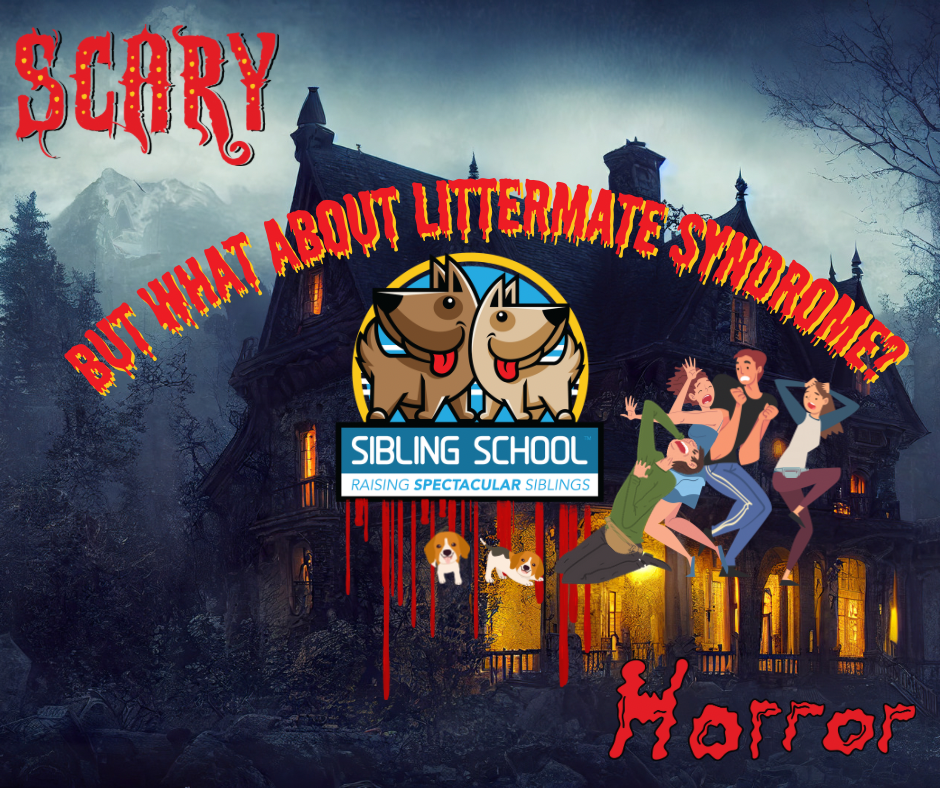2020 Update! This blog has become one of the most viewed on our site, and the request for more detailed help raising siblings have been pouring in. To help meet that need we have developed an e learning course devoted to best practices for raising sibling puppies or puppies of similar age and Sibling School is now available on demand!
Haven’t we all heard the predictions of doom that descend when the subject turns to raising litter mates. Read a few comments on social media and you might think that anyone raising two puppies at the same time was making what must be the worst mistake anyone has ever made in the history of mistakes. You’ll never find more freely flung advice to rehome, return, or otherwise get rid of a pet than when the discussion of raising litter mates comes up.
The problem is, there is so much focus on shaming and scaring people into rehoming or returning one puppy that helpful and productive information gets drowned out, and too many owners feel bullied and may not seek out help with their puppies for fear of being judged.
Yet, many people have successfully raised well balanced, well adjusted, dogs of the same, or similar age. The question becomes what are these successful owners doing that enables them to raise two behaviorally typical and well adjusted dogs of the same or similar age?
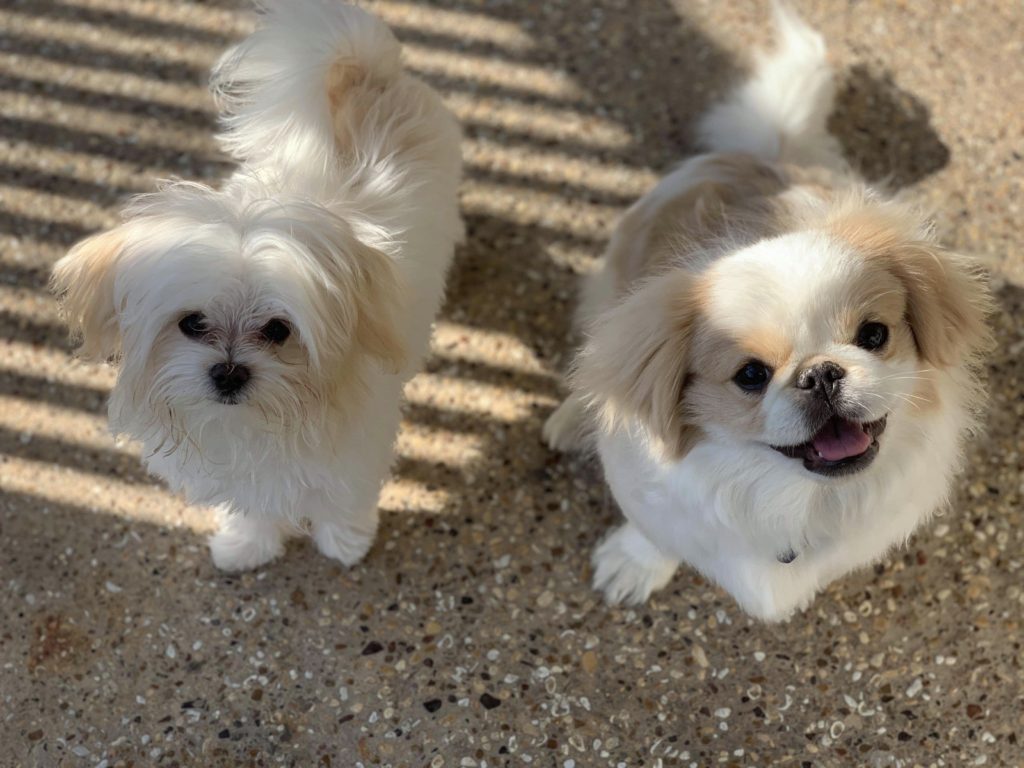
As a breeder of German Shepherd Dogs for over twenty five years, and a professional dog trainer, I have raised multiple sets of siblings from cradle to grave. All have been well adjusted, accomplished, and behaviorally typical for their breed, age, gender, and environment. So I decided to compare our basic list of best practices to fellow breeders, trainers, and companion dog owners to help others who may find themselves raising two puppies close together in age at the same time.
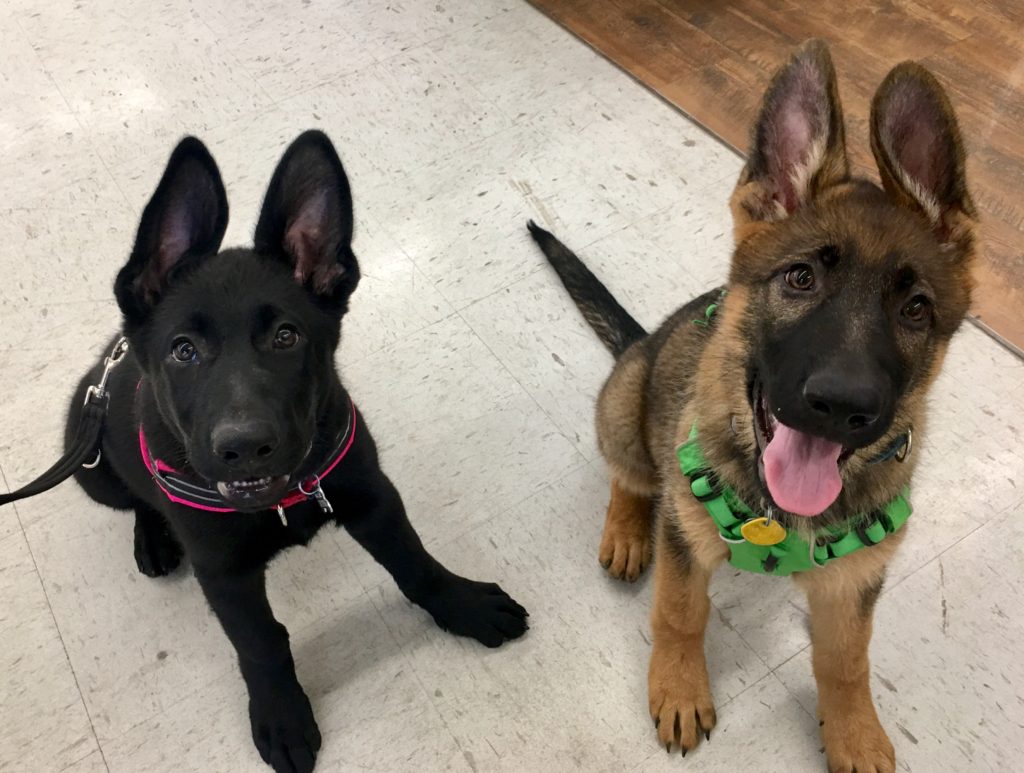
5 Tips for Raising Spectacular Siblings.
The truth of the matter is that raising two puppies is more work, and more expensive, than raising one.
To be exact, raising siblings is three times as much work as raising a single puppy. While it’s true that a novice pet owner might think that raising two puppies will be easier because the puppies will have a playmate at hand all the time, the opposite is the reality.
Why? Because one of the most common pitfalls of raising two puppies of the same age is the puppies can become overly bonded to each other, unresponsive to their owners, and pugnacious with each other.
Preventing this takes hard work, thought out plans, effective and safe positive reinforcement based training, and behavior management techniques.
Following were the tips that everyone we surveyed shared in common.

Tip 1: I need to be treated as an individual.
When raising two puppies it’s vitally important that both puppies have solo experiences. This means three times as many scheduled socialization outings, teaching, and practice sessions need to be planned and executed.
Puppy 1, Puppy 2, and Puppies 1 and 2 together.
Camille Person CDBC and trainer at Pawsitive Futures Dog Training lists
“Individual socialization outings and training one pup at a time” as her top tip and this was mirrored by many others.
Here is a sample of 1 week of socialization for Norma and Mesa.
Monday: Mesa goes to Tractor Supply and a walk around the outdoor sidewalk area. Mesa practices all the skills she loves to do.
Tuesday: Norma goes to Tractor Supply and a walk around the outdoor sidewalk area. Norma practices all the skills she loves to do.
Wednesday: Both puppies stay home, this is a training day, so both Norma and Mesa have a 5 minute solo learning new skills session. Later that day Norma and Mesa have a dual puppy practice ‘Skills I Know’ session. It’s important that puppies learn NEW skills individually, and practice KNOWN skills together.
Thursday: Mesa and Norma go together to Tractor Supply. This requires two humans! We walk the entire store, first by taking the puppies opposite directions (teaching them just because we go somewhere together doesn’t mean we stay together) around the store, then once around together. Each puppy needs it’s own handler so that each puppy’s response to the exposure is maximized. Both girls practice known behaviors when separated and when together.
Friday: A learning day same as Wednesday.
Saturday: Mesa goes to Atwood’s, Norma stays home with a high value chew. Mesa practices all her favorite behaviors.
Sunday: Norma goes to Atwood’s and Mesa stays home with a high value chew. Norma practices all her favorite behaviors.
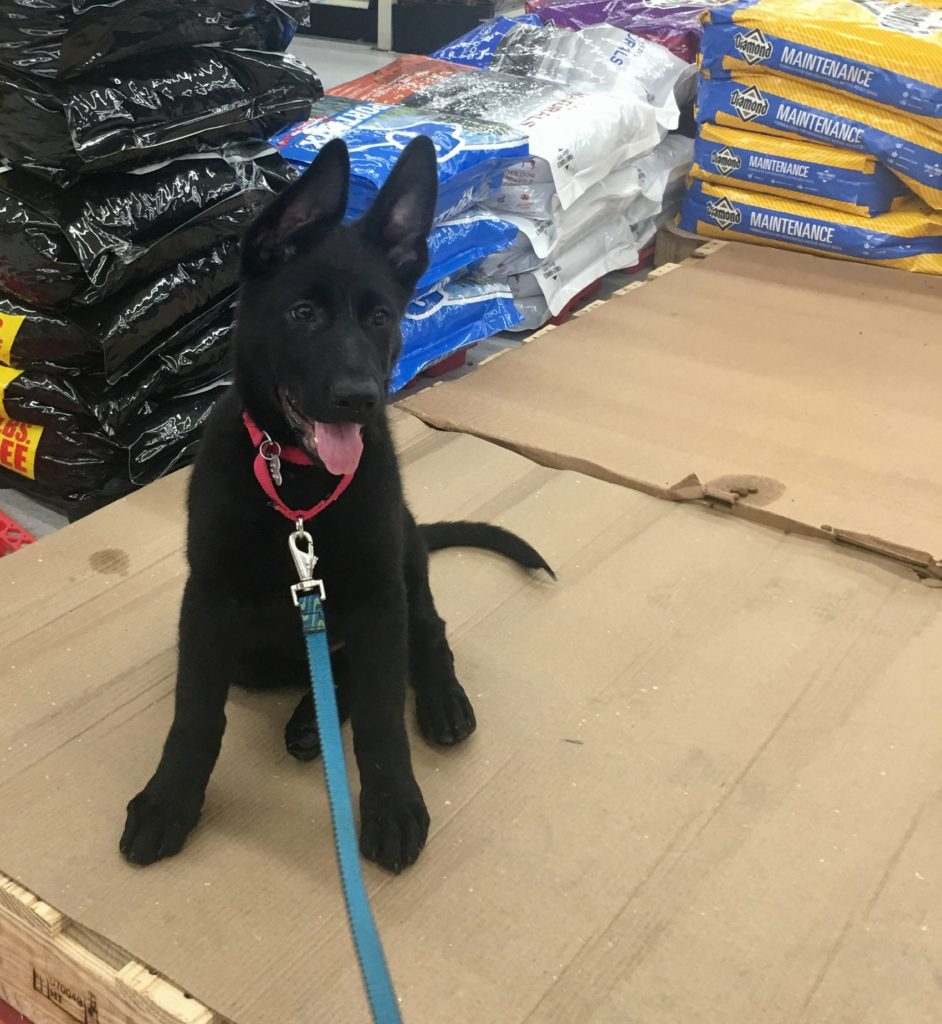
Tip 2: I need my own stuff and space!
Yup, you guessed it, raising two puppies is also twice as expensive as raising one. Plan and budget for two sets of supplies, this means a minimum of two crates (4 if you plan on sleeping crates in the bedroom, and day crates in the living room), two x pens, two collars, harnesses, bait bags, leashes, long lines, Pacifiers for two, bowls for two, and travel/training kits so you are prepared on outings and at class.
Charissa Carvel of Colorado Animal Rescue says
”Have them sleep in separate crates” as her top tip and again this was a very common recommendation.
While it may be ok to have puppies crated side by side at first, it’s important to gradually separate the crates as the weeks go by. Eventually the puppies should be able to be perfectly happy and content being crated in different rooms, different parts of the house, and even at home alone when the other puppy has an outing.
Puppies also need to eat in privacy, both crated, and also one crated and the other one loose. Same goes for pacifiers, puppies can be crated with chews and pacifiers, one crated (with the best pacifier) and one loose, or both loose (if both puppies are loose with pacifiers be sure you have twice as many pacifiers as puppies!). Want to really Level UP your feeding? Practice feeding one puppy crated, while the other puppy has a learning session, then switch.

Tip 3: I need to have my own friends.
When raising siblings it’s tempting to have them playing only with each other, but the truth is that puppies don’t raise well adjusted dogs any more than children raise well adjusted adults. Our puppies need adult dog role models to teach them appropriate social skills, and they need appropriate and safe dogs of various ages to interact with.
This means if you are raising two puppies and you don’t have any other dogs that you may find you need to seek out a safe and suitable group of older dogs for your puppy to socialize with. This can take the form of a well run play group, group walks, or even something as simple as taking a walk with the puppy with a friend’s puppy suitable dog.
Tip 4: I need my own class!
Puppies, both companion puppies to show and sport puppies, benefit from a well run positive reinforcement puppy class. How class instructors handle sibling puppies varies from trainer to trainer but here are some good guidelines.
A simple solution is to schedule 2 puppy classes, on different nights, and take each puppy to class individually. Not only will this allow you to focus on the needs on the puppy individually, it also gives the puppy who stays at home practice staying home alone (with a high value pacifier of course!)
If this is too time consuming or difficult to afford or schedule another option is to alternate puppies. Each puppy attends class one week, the other puppy the next week, until the class is complete. Again allowing each puppy to experience class solo and staying home solo.
A third option is to bring both puppies together to class, plus a crate. One puppy is crated while another puppy is working, again this is excellent practice for what many show and sport puppies will be experiencing as adult dogs.
Finally, you can bring both puppies and two handlers, so each puppy has it’s own person and while they are in class together they are having different class experiences.
Each of these scenarios has pros and cons and if your puppies take multiple classes you may find you do some version of each of these, all the better! It’s important for puppies being raised together to experience the world as individuals, but also as a team.
Occasionally you may find trainers in your area are more hung up on why you should NOT be raising two puppies at once than they are interested in helping you be successful. Don’t be afraid to politely leave and seek out a different trainer, who is prepared to help you reach your goal with your dogs.
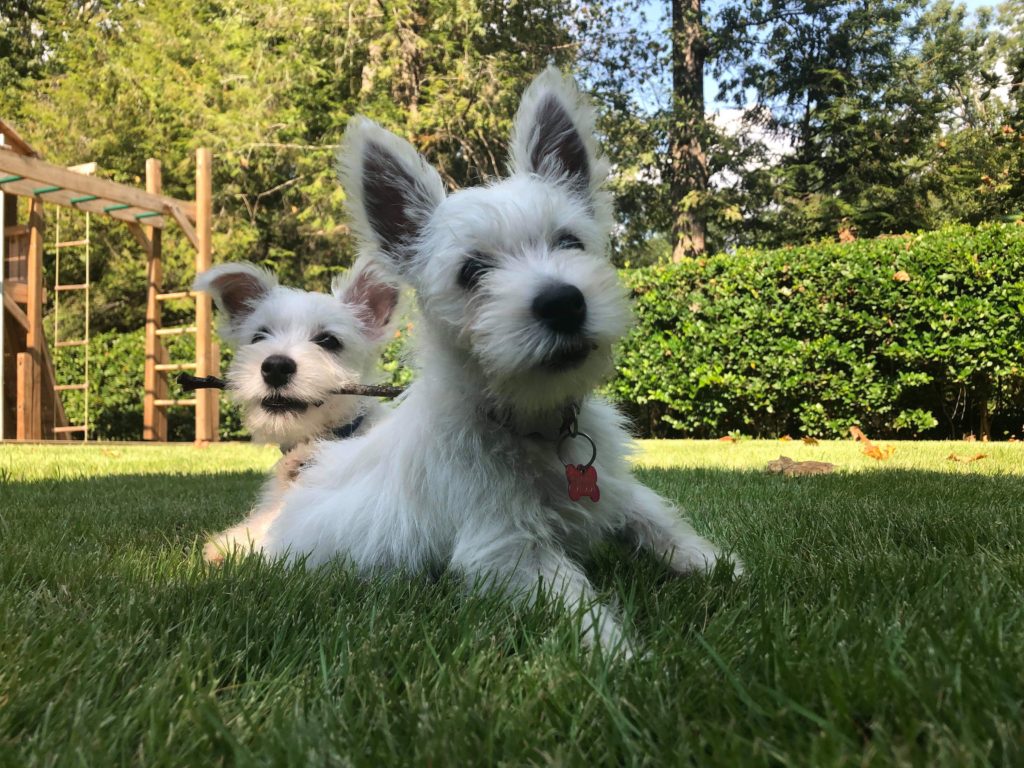
Tip 5: I need skills, man! Mad Skills!
Because sibling puppies are usually going to be together much of the time, they need skills that a single puppy, or a puppy in a household of boring adult dogs, doesn’t need.
Remember, puppies don’t do a great job raising other puppies. So don’t count on your puppies to “bring out the best” in each other, because they won’t. They will, if allowed to run untrained and unmanaged, become pugnacious and unresponsive to us. So, it’s extremely important that our puppies have mad skills, and that we teach and practice these daily. Raising two puppies is NOT for the faint of heart, or those who don’t want to work hard with their puppies. Here are some skills your puppies will need to learn, practice, and value highly suggested by Carrie Brooks of Go Rogue Dog Training.
- Come when called away from play.
- Learn how to take breaks from rowdy play to lower excitement activities.
- Come when called and then engage with a kibble scatter.
- Come when called and then practice known behaviors for a few moments before being released to play again.
- Learn to settle on a mat, in a crate, and on a tether, while the other puppy is working.
- Learn to Settle on a bed inside.
- Learning to be calm in the house when together.
- Learning to settle while the other puppy is working, then switching, and taking turns.
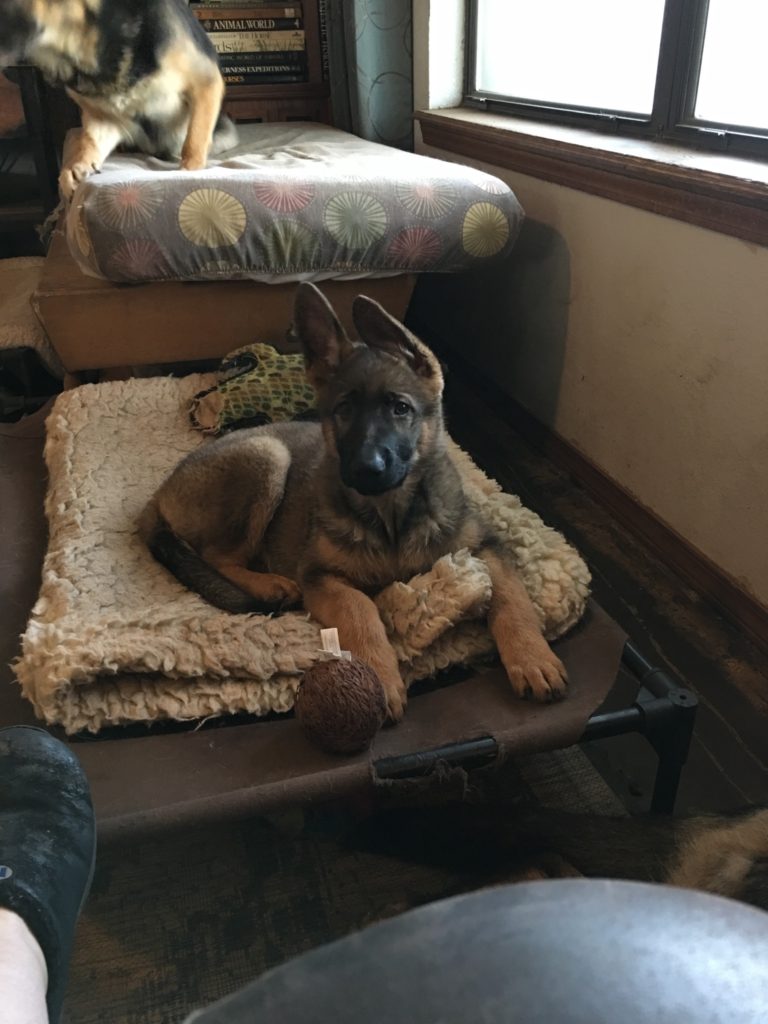

Some of the most important skills for sibling puppies involve managing excitement and arousal during play. Remembering that puppies often bring out the worst behavior in each other, it’s vitally important that your puppies are not permitted to run wild.
When puppy play becomes too rough, if puppies are starting to bicker, or “hen peck” at each other it’s time for immediate human intervention. A kibble scatter, recall to settle, or crating one or both puppies with a pacifier are all ways to diffuse excitement and arousal in the moment.
Keeping well stocked success stations, keeping kibble in your pockets, and stuffed pacifiers in your freezer, are all requirements when dealing with two puppies growing up together. You may even find there are entire weeks when the puppies are not spending much time together.
Siblings, a warning and some reality checks.
I’m often asked about raising two puppies together by people who are considering this. I always say whenever we have multiple dogs we must consider the potential exists that our dogs won’t get along forever.
So, before you bring litter mates, or two puppies close together in age into your life ask yourself a few questions.
1. If my dogs don’t get along in a few years am I willing to live a “crate and rotate” lifestyle? If no, don’t own multiple dogs.
2. Am I financially able to afford two sets of health care costs, including emergencies and chronic health conditions? If not, don’t own multiple dogs
3. Do I have the free time and inclination to raise two puppies at once and do them BOTH justice? If not, don’t own multiple dogs.
4. Is the breed of dog I’m considering typically dog social? If not, am I skilled enough to handle dogs who may not tolerate each other after puberty, or who may exhibit risky behavior in a group?
5. Should I chose same sex (very risky in breeds with same sex aggression) or opposite sex (how will I keep them from breeding?) puppies? These are questions you must discuss with your breeder. If you are choosing puppies from a rescue they will likely come to you already sterilized so risk of breeding is zero, but with an unknown history and heritage risk of dog intolerance or same sex aggression are impossible to determine in puppies.
Further, if you are a breeder, foster, or rescue and you are considering placing litter mates, or puppies of similar age, into the same home you owe it to your client and your dogs to discuss in depth the contents of this blog. Really discuss the traits present in your breed and the likelihood they will remain familiar dog social for life, discuss what happens if they don’t, and really hash out how much work raising two puppies is. Then, put in a little hard work yourself and follow up and support that client throughout the first two years, always being prepared to take one dog back if the placement turns out to NOT be in the best interest of all involved, human and canine.
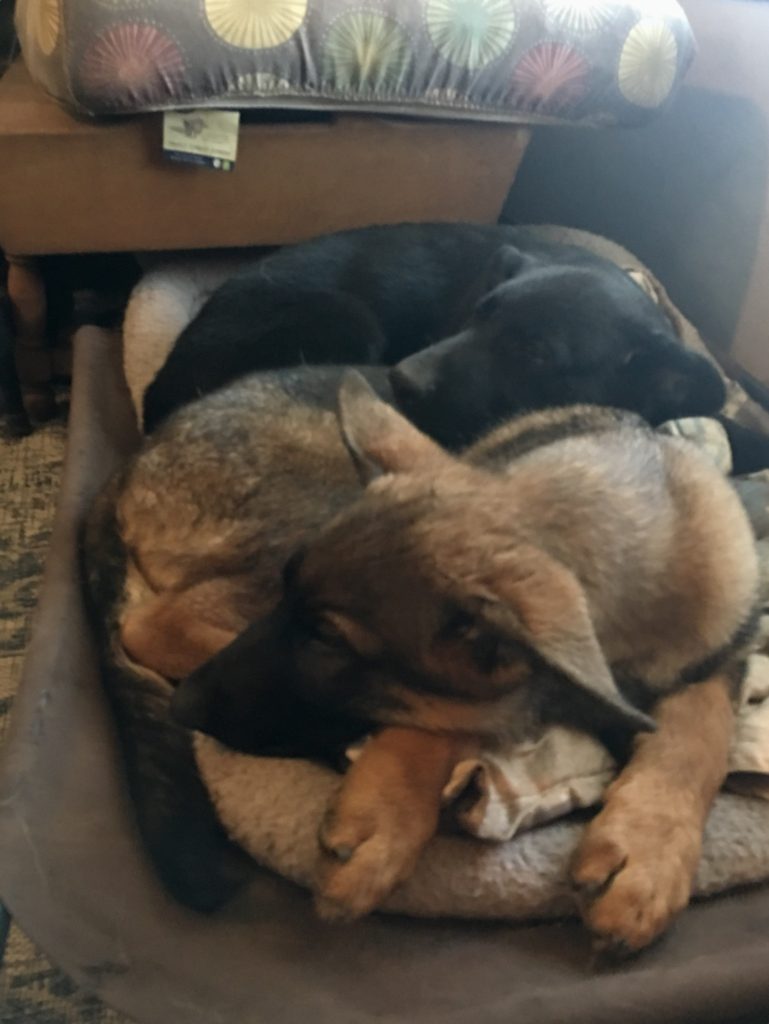
Are you raising siblings? We want to help, we offer distance consulting and (drum roll) soon we will be adding an E learning course and support group devoted to raising Spectacular Siblings. Contact us to learn more!



